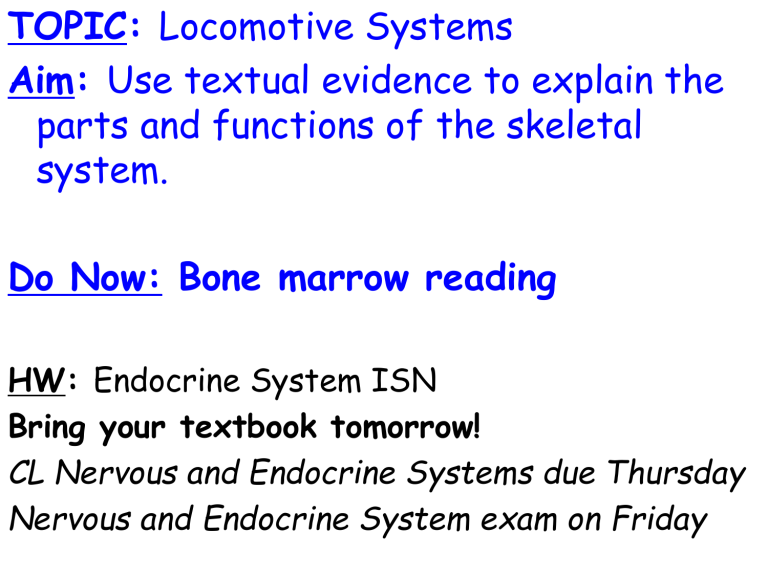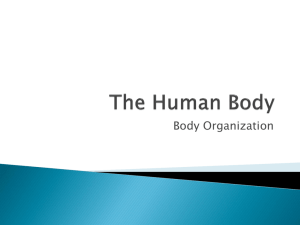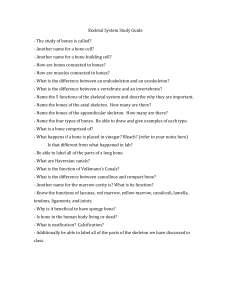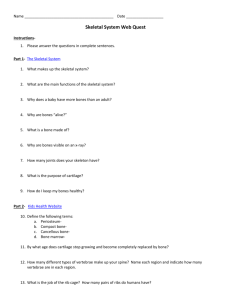What are the parts and functions of the skeletal system?

TOPIC: Locomotive Systems
Aim: Use textual evidence to explain the parts and functions of the skeletal system.
Do Now: Bone marrow reading
HW: Endocrine System ISN
Bring your textbook tomorrow!
CL Nervous and Endocrine Systems due Thursday
Nervous and Endocrine System exam on Friday
D
A
E
C
The diagram shows neurons working together in a reflex action.
B
1. Identify each labeled structure.
2. Identify the chemical released into area X and the structures that the chemical attaches to.
3. Identify the part of the neuron that releases the chemical.
4. Identify the division of the nervous system that neurons
A and C are found.
5. Identify the division of the nervous system that neuron B are found.
C
Cerebrum
Memory, thinking and reasoning
Medulla oblongata
A
Involuntary activities
B
Cerebellum
Balance and coordination
• The smallest is the stirrup bone in the ear which can measure 1/10 of an inch.
Your face has 14 bones.
One fourth of your bones are located in your feet .
True or False: Children often bend their bones rather than break them.
TRUE!
Their bones are more pliable, and tend to bend more without breaking.
1.
Describe the functions of the skeleton.
• Gives body shape & support
• Protects internal organs
• Attaches to muscles to help bones move
• Produces blood cells
• Stores calcium and phosphorus
2. Which life process does the skeletal system help carry out?
• LOCOMOTION
3.
Describe the two types of bone marrow.
• Yellow marrow = fat cells
• Red marrow = produces blood cells
4. Identify the systems that regulate locomotion.
• Nervous and endocrine systems
5. Describe the function of ligaments.
• Tough band of tissue that holds bones together
6. Describe the function of tendons.
• Tough band of tissue that connects muscles to bones
7.
Describe 4 characteristics of cartilage.
• Smooth and slippery
• Flexible
• Acts as a shock absorber
• Makes movement easier by reducing friction that would be caused by bones rubbing together
• Does not contain blood vessels
Nutrients delivered by nearby blood vessels
• Give shape to certain body parts (ears, nose)
• Skeleton of newborn made mostly of cartilage
8. Identify some locations of cartilage in your body.
•Trachea
• In between vertebrae
• At ends of bones
• In joints
TOPIC: Locomotion
Aim: Explain the structure and functions of the 3 types of muscles.
Do Now: Take out endocrine system ISN and skeletal system notes.
HW: Ditto – Nervous System Review
CL Nervous and Endocrine Systems due
Thursday
1. Identify each labeled gland in the diagram. Leave space under each gland.
2. Under each gland, write the hormone(s) released and the function of the hormone(s).
3. In a complete sentence, identify how hormones are transported throughout the body.
4. In a complete sentence, identify the types of cells that are affected by hormones.
5. In a complete sentence, identify the proteins that hormones attach to on these types of cells.
8. Identify some locations of cartilage in your body.
•Trachea
• In between vertebrae
• At ends of bones
• In joints
Cranium = Skull
Clavicle = collar bone
Rib cage
Scapula (shoulder blades)
Sternum = breast bone
Vertebrae = backbone
(spinal column)
Scoliosis
Humerus = upper arm bone
Ulna & radius = lower arm
Pelvis = hips
Femur = thigh bone (longest & strongest)
Patella = knee cap
Carpals = wrist bones
Metacarpals = hand bones
Phalanges = fingers & toes
Did You Know?
Humans and giraffes have the same number of bones in their necks? A
Giraffe ’ s neck vertebrae are just much, much longer!
The only bone not broken so far during any ski accident is one located in your inner ear.
If you break your wrist as an adult it will take you 8 weeks to heal.
A five year old child who breaks their wrist only takes 3 weeks to heal.
Babies are born without the patella (knee bone) it develops between ages 2 and 5.
Let ’ s summarize…
1. Identify structures that make up your skeletal system.
2. Identify the functions of your skeletal system.
3. Describe the difference between tendons and ligaments.
4. Explain the function of cartilage.
5. Where is cartilage found?
http://www.youtube.com/watch?v=8d-
RBe8JBVs&feature=related http://www.youtube.com/watch?v=iGVzD4so
DMo http://www.brainpop.com/health/bodysystem s/skeleton/
• http://www.bbc.co.uk/schools/podsmission
/bones/annie02.shtml
Which number in the diagram indicates a structure that transmits impulses from a receptor organ to an interneuron?
What is the chemical in the diagram?
1.a hormone important in maintaining homeostasis
2.an enzyme detected by a cell membrane receptor
3.DNA necessary for regulating cell functions
4.a food molecule taken in by an organism
1. Which gland in the diagram is related to disorders that affect proper functioning of a person's metabolism?
2. Which gland is disrupted in a person suffering from diabetes?
3. Which gland is related to disorders such as gigantism, dwarfism and acromegaly?






